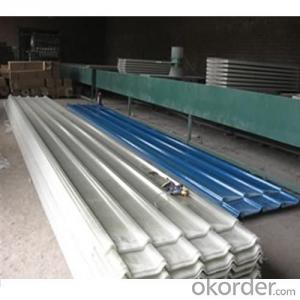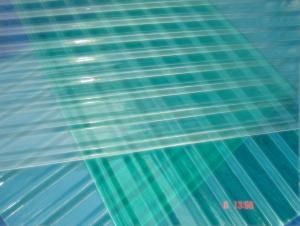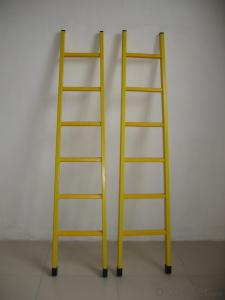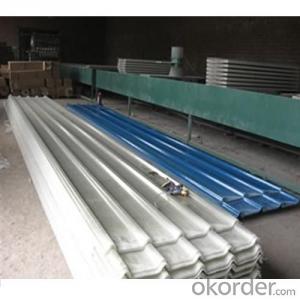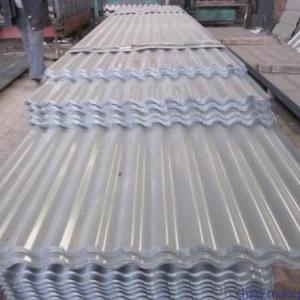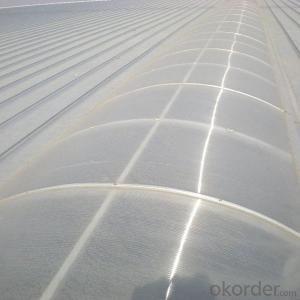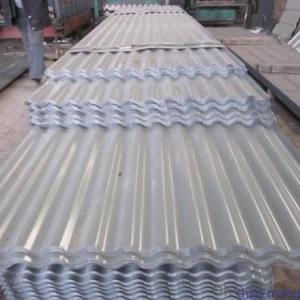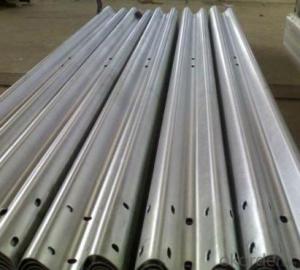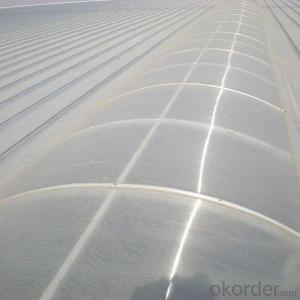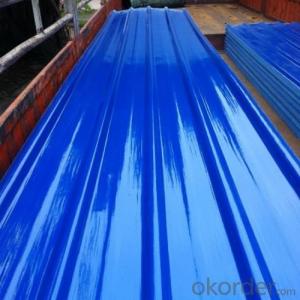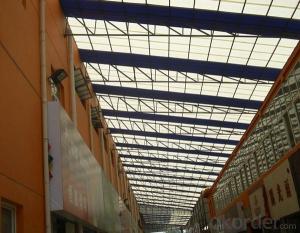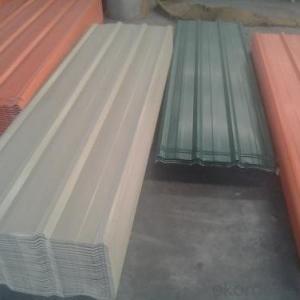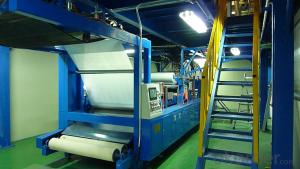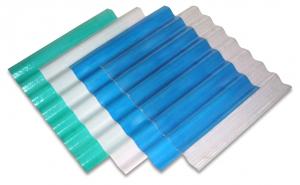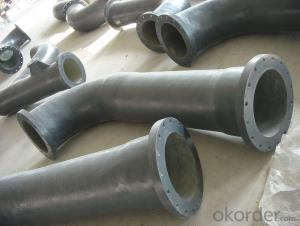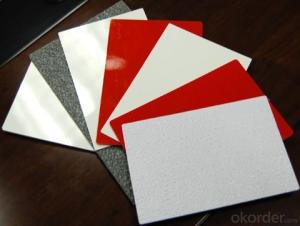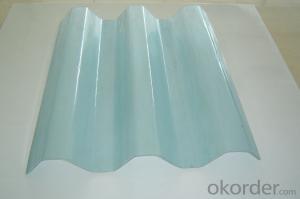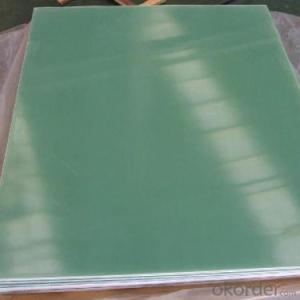FRP Roofing Panel - Fiberglass Panels for Diverse Applications
- Loading Port:
- Shanghai
- Payment Terms:
- TT or LC
- Min Order Qty:
- 20000 kg
- Supply Capability:
- 200000 kg/month
OKorder Service Pledge
OKorder Financial Service
You Might Also Like
Brief Introduction
the FRP anti-corrosion panel are produced in the same production line with FRP skylight panel, it has greater and more requirements of the professional technology. There are only a few of the manufacturers who can produce FRP opaque panels in China. A lot of FRP opaque corrugated panels have quality problems after intalled. Higoal is a mature manufacturer in producing FRP opaque corrugated panel (anti-corrosion panel), and has great advantages in both quality and lower cost.

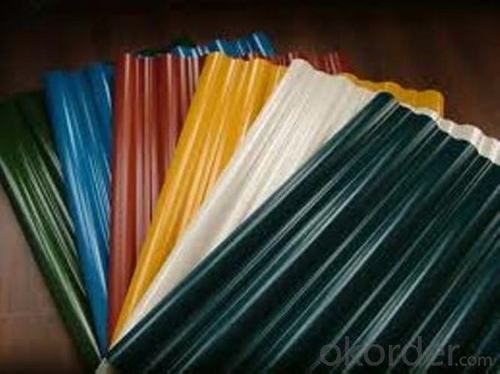
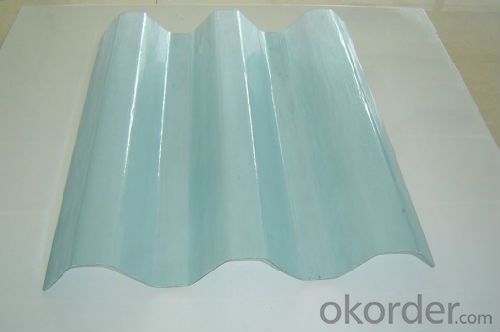
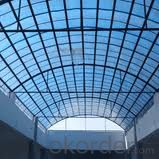
Characteristics
Mechanical properties: high rigidity lighting panels
Plate matches: match with general prepainted galvanized sheet, galvanized steel
Resin composites: Improved anti-aging SMR198 resin
Fiber reinforcement: E-glass fiber untwisted without glue
Surface treatment: affixing MELINEX301 film
Stiffener line: surface with longitudinal uniform distribution of anti-LAC gluten
Technical Specification
Glass fiber: not less than 28%
Unit Weight: 1800g / ㎡, 2400g / ㎡, 3050g / ㎡
Nominal thickness: 1.2 mm, 1.5mm, 2.0mm (tolerance ≤ 10%)
Temperature limits: -60 ℃ ~ +130 ℃
Transmittance (1.5mm): 72% ± 2% (fog white, sky blue, water green), 52% ± 2% (white porcelain)
UV-rate: 99%
Tensile strength: 90Mpa
Flexural strength: 160 Mpa
Elongation: 1.9%
Pap hardness: ≥ 50
Thermal expansion coefficient: 1.5 ~ 3.2 * 10-5 / K
Thermal conductivity: K = 0.23W / m * K
Guarantee: 15 years
NOTE: In special cases, the surface film varieties vary according to needs, such as Melinex389, PT055 and so on.
FAQ
Better property of corrosion resistant than clading panel and stainless steel, it was designed for the harsh conditions, which require products that can withstand corrosive chemicals, high temperature.
- Q: Can FRP roofing panels be used for covered walkways?
- Covered walkways can indeed utilize FRP roofing panels. The properties of FRP panels, which are made of Fiberglass Reinforced Plastic, make them well-suited for this purpose. One key advantage is their lightweight nature, facilitating easy installation and maintenance. Moreover, they boast high durability and resistance against corrosion, UV rays, and other environmental factors. Consequently, these panels can endure the test of time, offering long-lasting protection for the covered walkways. Additionally, FRP panels come in a variety of colors and designs, enabling customization to match the walkway's aesthetic requirements. All in all, FRP roofing panels provide a dependable and cost-effective choice for constructing covered walkways.
- Q: Do FRP roofing panels require any specific safety measures during installation?
- Yes, FRP (Fiberglass Reinforced Plastic) roofing panels do require specific safety measures during installation. Here are some important safety measures that should be followed: 1. Personal Protective Equipment (PPE): Installers should wear appropriate PPE such as safety glasses, gloves, and non-slip footwear. This will protect them from potential hazards such as sharp edges or falling debris. 2. Safe Work Environment: Before starting the installation, ensure that the work area is clear of any obstructions or tripping hazards. It is important to maintain good housekeeping practices to minimize the risk of accidents. 3. Fall Protection: If the installation requires working at heights, fall protection measures such as harnesses, guardrails, or safety nets should be implemented. Installers should be properly trained in the use of fall protection equipment. 4. Proper Lifting Techniques: FRP roofing panels can be heavy, so it is important to use proper lifting techniques to avoid strains or injuries. Team lifting or using mechanical lifting devices may be necessary depending on the weight and size of the panels. 5. Power and Tool Safety: If power tools are used during installation, they should be operated according to the manufacturer's instructions and only by trained personnel. Electrical safety precautions, such as using grounded tools and avoiding wet conditions, should also be followed. 6. Weather Conditions: Weather conditions can impact the safety of installation, especially when working at heights. Installers should be aware of potential hazards such as strong winds, rain, or lightning and take appropriate precautions, such as rescheduling the work if necessary. 7. Training and Supervision: It is essential that all installers are properly trained in the installation techniques and safety measures specific to FRP roofing panels. Regular supervision and communication about safety practices can help prevent accidents and ensure a safe working environment. By following these safety measures, the risk of accidents or injuries during the installation of FRP roofing panels can be significantly reduced, ensuring the safety of the installers and the overall success of the project.
- Q: Can FRP roofing panels be used for zoos?
- Zoos can utilize FRP roofing panels due to their durability, strength, and resistance to environmental elements. These panels are suitable for various applications, including zoos, where animal safety is paramount. When it comes to zoos, the use of FRP roofing panels brings several advantages. Firstly, they are lightweight yet robust, ensuring a secure and dependable roofing solution, especially in areas prone to heavy snow loads or strong winds. Secondly, FRP panels possess exceptional resistance against UV radiation, preventing fading, discoloration, or degradation caused by prolonged sun exposure. This is vital for maintaining the zoo's aesthetics and ensuring visually pleasing enclosures for the animals. Furthermore, FRP roofing panels exhibit low thermal conductivity, which aids in regulating the temperature within the enclosures. This contributes to a more comfortable and controlled environment for the animals. Additionally, these panels provide excellent insulation, resulting in energy efficiency and reduced heating or cooling costs. Moreover, FRP roofing panels offer a wide range of colors, textures, and designs, enabling zoo designers to create visually appealing enclosures that mimic natural habitats. This enhances the overall experience for visitors while providing a more stimulating and enriching environment for the animals. In conclusion, FRP roofing panels serve as a versatile and reliable roofing solution for zoos. Their durability, resistance to environmental factors, and aesthetic options make them a suitable choice for creating safe and visually appealing enclosures for animals.
- Q: Can FRP roofing panels be used for modular office buildings or construction sites?
- Yes, FRP (Fiberglass Reinforced Plastic) roofing panels can be used for modular office buildings or construction sites. FRP roofing panels are known for their durability, lightweight nature, and resistance to corrosion, making them a suitable choice for such applications. They are often used in industrial and commercial settings where strength and longevity are important factors. Additionally, FRP roofing panels offer excellent thermal insulation and can withstand extreme weather conditions, making them a reliable choice for outdoor structures. Their easy installation and low maintenance requirements also make them a cost-effective option for modular office buildings or construction sites.
- Q: Can FRP roofing panels be used for covered walkways or bike shelters?
- Yes, FRP roofing panels can be used for covered walkways or bike shelters. FRP (Fiberglass Reinforced Plastic) roofing panels are lightweight, durable, and resistant to weathering, making them suitable for such applications. They provide protection from the elements and can be easily installed, making them a practical choice for covered walkways or bike shelters.
- Q: Can FRP roofing panels be used for bus shelters?
- Yes, FRP (Fiberglass Reinforced Plastic) roofing panels can be used for bus shelters. FRP roofing panels are commonly used in various architectural applications due to their durability, lightweight nature, and resistance to weather elements such as UV radiation, rain, and snow. These panels are also known for their excellent insulation properties, which can help maintain a comfortable temperature inside the bus shelter. Additionally, FRP roofing panels can be easily installed and require minimal maintenance, making them a suitable choice for bus shelters that need to withstand frequent use and exposure to outdoor conditions.
- Q: What are the advantages of using FRP roofing panel?
- The advantages of using FRP roofing panels include their lightweight nature, durability, and resistance to corrosion, chemicals, and UV rays. They also offer excellent insulation properties, easy installation, and low maintenance requirements. Additionally, FRP roofing panels are cost-effective and have a long lifespan, making them an ideal choice for various applications.
- Q: Are FRP roofing panels suitable for military buildings?
- Military buildings can benefit from the use of FRP (Fiberglass Reinforced Plastic) roofing panels. These panels are popular in military construction because they are durable, strong, and can withstand different weather conditions. Despite their lightweight nature, they possess exceptional structural integrity, making them perfect for military buildings that require reliability and strength. FRP roofing panels are also known for their ability to resist corrosion, chemicals, and UV rays, which are crucial considerations for military buildings in harsh environments. They can endure extreme temperatures, heavy impacts, and strong winds, ensuring the safety and longevity of the structures. Moreover, FRP roofing panels are easy to install and maintain, making them a cost-effective solution. They necessitate minimal upkeep and do not require regular painting or coating, reducing overall maintenance costs and efforts for military buildings. Additionally, FRP roofing panels provide excellent insulation properties, contributing to thermal efficiency and noise reduction. This is particularly advantageous for military buildings such as command centers, barracks, or training facilities, where temperature control and soundproofing are crucial. In conclusion, FRP roofing panels are a suitable choice for military buildings due to their durability, strength, resistance to various elements, ease of installation and maintenance, as well as their insulation properties. They offer reliable protection and long-lasting performance, making them an ideal roofing solution for military facilities.
- Q: Can FRP roofing panels be used for agricultural structures?
- Agricultural structures can indeed utilize FRP (Fiberglass Reinforced Plastic) roofing panels. Due to their durability, strength, and ability to withstand different environmental factors, FRP panels have become a popular choice for agricultural buildings. These panels are lightweight, allowing for easy installation and handling, while still maintaining exceptional structural integrity. In terms of weather resistance, FRP roofing panels are specifically designed to endure extreme conditions such as strong winds, heavy snow loads, and intense sunlight. Additionally, they are resistant to corrosion, rot, and pests, making them well-suited for agricultural structures that may encounter moisture or harsh chemicals. Moreover, FRP roofing panels provide excellent insulation, ensuring a comfortable temperature within agricultural buildings. This is particularly beneficial for structures like greenhouses, where maintaining the right temperature is crucial for successful plant growth. In summary, FRP roofing panels offer a cost-effective and long-lasting solution for agricultural structures. They provide the necessary protection and durability required for a range of farming applications, including barns, storage sheds, poultry houses, and more.
- Q: Are FRP roofing panels resistant to wind damage?
- FRP (Fiberglass Reinforced Plastic) roofing panels possess a general resistance to wind damage. Their durability and strength are well-known, enabling them to withstand strong winds. The inclusion of fiberglass reinforcement in these panels provides them with strength and flexibility, ensuring they can withstand the forces of strong winds without bending or breaking. Moreover, FRP roofing panels are typically equipped with secure fastening systems that further enhance their resistance to wind damage. However, it is important to acknowledge that the extent of their resistance to wind damage can vary depending on factors such as the method of installation, the thickness of the panels, and the specific wind conditions in a given area. Hence, it is always advisable to seek guidance from a professional installer or manufacturer regarding the wind resistance capabilities of FRP roofing panels for a specific project.
Send your message to us
FRP Roofing Panel - Fiberglass Panels for Diverse Applications
- Loading Port:
- Shanghai
- Payment Terms:
- TT or LC
- Min Order Qty:
- 20000 kg
- Supply Capability:
- 200000 kg/month
OKorder Service Pledge
OKorder Financial Service
Similar products
Hot products
Hot Searches
Related keywords
